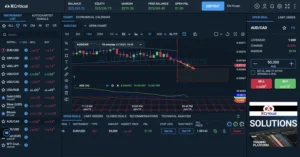The movement of stock prices is not always what it may seem. Beneath the superficial up and down motion, trends can lurk – or gradual reversals may occur. Therefore, traders look for signs of enthusiasm if they need to confirm or refute price signals. Trading volume used to measure the number of securities exchanged over a given period helps with this. Let’s discuss what this indicator is and how it can be improved.
The definition of brokerage trading volume
Trading volume is the number of daily shares or contracts owned by a given security dealing. It is a measure of the number of stocks that have been traded in a given period. Such a market indicator refers to the overall activity of security. Investors use this parameter to confirm the existence or reversal of a trend, which makes it easier to decide whether to buy or sell an asset.
Increasing or above average volume means traders are committed to a price move. Conversely, if the volumes are decreasing or below average, it signals a lack of enthusiasm.
Each exchange monitors its trading volume and provides information. Such data is published every hour during the day; however, the such market indicator is approximate. Real numbers become available the next day.


Turnkey Brokerage Solution For Your Business
Get the most profitable fully licensed fx/crypto brokerage software or ready-to-operate business in 48 hours. Best-in-class web & mobile trading platforms, sales-driven CRM, full integration with MT4/5, and 150+ payment providers.
Pros and cons of high and low volume stocks
All shares are divided into high and low volumes, considering their market activity. Stocks with high volume are in significant demand, while shares with small parameters require a more subtle approach. There is no clear distinction between these categories of securities. However, stocks with a large volume are traded from 500,000 per day; this figure is less for shares with a low amount.
Advantages of high volume shares:
- Small volatility means you are less likely to see significant price changes throughout the day, which reduces the risk factor.
- Narrow spread: stocks with a large trading volume have a minor difference between their bid and ask prices. A smaller spread creates more buying and selling opportunities among investors.
- Minimal liquidity risk: liquidity refers to how easy it is to convert assets into cash. As a rule, most investors trade shares with large volumes, which reduces the risk you will not be able to exchange the asset.
The disadvantage of such securities is that more speculation may be required. For example, a person might invest in penny stocks that sell for high prices. Such assets could create good opportunities if they take off. However, the investor will have to take on significant risk when dealing with an unverified company.
The main advantage of low volume shares is their significant potential: shares traded in small volumes are promising for investors. These securities are less in demand, but their value may increase in the long run. Users may also cheaply buy stocks that are rising.

However, they also have some downsides:
- Significant volatility risk: low trading volume makes share prices sensitive to volatility. It means investors may experience higher price fluctuations than when buying stocks that are exchanged hundreds of thousands of times daily.
- Decrease in liquidity: since the volume of financial transactions is smaller, it can be more difficult for an investor to find a buyer if they want to get rid of shares quickly.
It is difficult to say what is a good trading volume of securities since it must be considered in context with other indicators, including price trends, charts and volatility. Any trading volume that indicates a security’s price action (and a sense of interest in buying such assets) can be considered reasonable.
Some ways to increase trade volume
The main secret of increasing sales for brokers lies in analysis and correct work with information. Tech companies are creating user-friendly AI-powered systems to help financial market professionals manage and use data. Thus, the opportunity to process large volumes of information, previously the prerogative of big business, has become available to small firms. Here are some non-technical ideas on how to increase sales:
- Track marketing campaigns correctly: as competition between brokers increases, those who know how to extract value from the information generated by marketing efforts can manage their advertising budget more effectively and communicate messages to target audiences more accurately.
- Listen to clients’ opinions: do not forget that traders know the market situation best. In smaller brokerage firms, technicians or sales managers monitor the content of conversations with clients regarding CS, sales, and retention. If this data gets to the right people, it may convey important information to senior management. However, large-scale listening requires significant technical infrastructure, just like lead tracking.
- Add trending assets as soon as possible: this follows from the previous paragraph, but it is worth considering in more detail. If a broker does not listen to the traders it works with; it runs the risk of adding assets after they have entered a trend or even after interest in them has declined. In a saturated market, when almost all competitors offer similar instruments with the same spread on similar platforms, it is essential to use every chance to stand out from the crowd.
- Tell stories: people try to find someone who can clearly tell the market’s complexities. Potential traders are interested in something other than the educational section with obscure terms. They want to hear a story told compellingly. We mean something more than industry news. These are conversations for information, discussions of events with authoritative people, and hot conclusions. Stories accelerate understanding and give confidence; only a confident trader can achieve success.
Trading volume is the number of shares dealing in a given time. Investors combine this data with other information to predict whether stock prices will go up or down. Low numbers may mean a lack of interest in buying and selling. It may be a bullish signal if the low volume is seen in a downtrend and a bearish sign if we deal with an uptrend.






